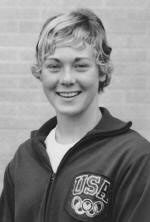
Keena Rothhammer (USA)
Honor Swimmer (1991)
FOR THE RECORD: OLYMPIC GAMES: 1972 gold (800m freestyle), bronze (200m freestyle); WORLD RECORDS: 2 (400m, 800m freestyle); NATIONAL CHAMPIONSHIPS: 12 (200yd, 400m, 500yd freestyle; 7 relays); WORLD CHAMPIONSHIPS: 1973 gold (100m freestyle), silver (400m freestyle); AMERICAN RECORDS: 13 (200yd, 400yd, 400m, 500yd, 800yd, 800m freestyle; 5 relays).
A talented freestyler with a racing range from 200 meters to 1500 meters, Keena Rothhammer’s performances were unpredictable except for the fact that she always won something. At a time when Shane Gould of Australia and Shirley Babashoff of the United States were swimming all the freestyle distances as well, this trio of swimmers flip-flopped their way down the event list, each pushing the other to new heights.
As youngest event gold medalist in both Olympic and World Championship competition, Keena, with the help of her Santa Clara coach, Hall of Famer, George Haines, set the world on fire. At age 16, Keena had accumulated an Olympic gold and bronze medal, two world records, fifteen U.S. National championships, ten American records, and a gold and silver medal at the first World Championships in 1973.
At the 1972 Munich Olympics, Keena was America’s third fastest 800 meter freestyler, but she captured the gold medal with a world record of 8:53.68. As the top seeded American in the 400, Keena came in sixth, but maintained her place in the 200 b3hind Gould and Babashoff to take the bronze medal.
The swimming dominance of Rothhammer allowed her to use her fame to convince the Amateur Athletic Union to change its strict, long-standing rule on women’s racing suits. The American suits were required to have a skirt around the hip, while the East Germans competed in skin tight suits–and won! Due to the Rothhammer family’s lobbying efforts, the AAU changed its tune and submitted to faster and more water resistant suits.
Keena’s forced retirement was due in part to severe migraine headaches which began in junior high school. After her retirement at age 17, she traveled around the country working with Special Olympics programs. Although just a teen, Keena maturely stated she would much rather be remembered for her work with children than anything she did in swimming.
